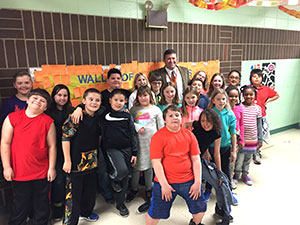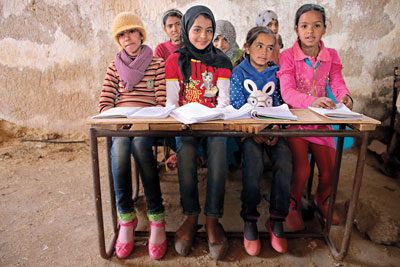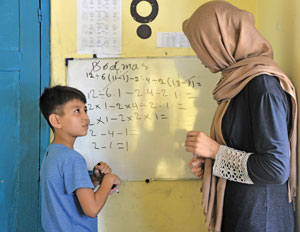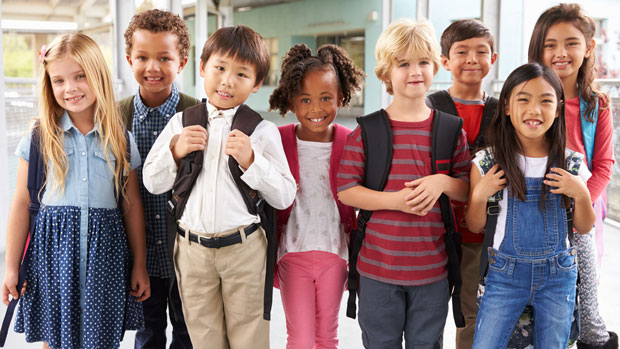In January, the elementary students at North Fond du Lac Schools in Wisconsin took on their most ambitious art project to date. Each of the more than 400 children, from kindergarten through fifth grade, wrote one thing they were thankful for on a strip of construction paper. Then they made paper “rings” of those expressions of gratitude before weaving them together to create one giant “gratitude chain.” Their goal? To create a colorful paper chain that could wrap around the entire school, surrounding it (both literally and figuratively) with gratitude.
The project, says art teacher Alice Tzakais, was the culmination of the school’s Happiness Week, which included a variety of activities centered on expressing gratitude and happiness. “Our theme is the power of happiness,” explains Alice, who is now in her 40th year as a teacher.
The school has seen firsthand how powerful happiness can be in the lives of both students and teachers. Since Aaron Sadoff became superintendent eight years ago, following three years as principal, he has worked diligently to spread the message of positive psychology throughout the school.
 “He has a lot of energy and a lot of ideas,” Alice says. “He’s very positive and enthusiastic, and that’s what it takes to sustain a happier culture.” When his contract came up for renewal two years ago, Aaron negotiated to have the school board send him to California to complete The Orange Frog training program. That program, based on Shawn Achor’s best-selling book The Happiness Advantage, uses a parable about an orange frog named Spark to teach new ways of achieving positive results.
“He has a lot of energy and a lot of ideas,” Alice says. “He’s very positive and enthusiastic, and that’s what it takes to sustain a happier culture.” When his contract came up for renewal two years ago, Aaron negotiated to have the school board send him to California to complete The Orange Frog training program. That program, based on Shawn Achor’s best-selling book The Happiness Advantage, uses a parable about an orange frog named Spark to teach new ways of achieving positive results.“I came back and taught it to my teachers, custodians, secretaries—everyone in the district,” Aaron says. “How a teacher feels affects the students, so I knew that if we can change the way the teachers feel, we can affect the culture for the students.”
His teaching staff, he says, has taken the ideas and run with them. Today, Alice says, teachers know their character strengths and choose which ones they’ll develop and use in the classroom. They have developed a program to send the comic book version of The Orange Frog home with every elementary school student, along with a reading guide, to stimulate conversation.
“The idea is that this is something the family is supposed to do together,” Aaron says. “So while we’re improving literacy, it’s also teaching them the science of happiness.”
Learned happiness
The district of North Fond du Lac is part of a growing number of schools incorporating the principles of positive psychology into education. As happiness continues to become more relevant globally, more countries are looking at ways to measure and monitor the well-being of their populations. From specific education policies to grass-roots movements, the awareness of the role happiness plays in individual success is changing how teachers, schools and even countries are approaching education.
“The coolest thing is, you don’t sit around and talk about happiness. You don’t say, ‘Oh, look at me, I’m so joyous.’ It’s not like that at all,” Aaron explains. “What we’re doing is about recognizing what you’re grateful for, making social connections and focusing on the things that make us better individuals. And now there’s research that backs it all up.”
In the 2015 World Happiness Report, Richard Layard, director of the Wellbeing Programme at the Centre for Economic Performance at the London School of Economics, and Ann Hagell, Ph.D., studied the well-being and mental health of children around the world, and then introduced specific recommendations for improving those conditions. They noted the important role an educational environment plays in children’s happiness and recommended that meeting the needs of children meant establishing well-being as a major objective for schools. Their blueprint for action included:
- Creating a well-being code that all teachers, students and parents would be held to.
- Emphasizing praise rather than criticism.
- Introducing age-appropriate courses in positive life skills at all levels of education.
- Training teachers to identify and promote well-being and positive mental health in students.
The authors were able to show a direct correlation between children’s happiness and their intellectual growth. In 2011, a review of school-based programs providing social and emotional learning skills found that children who participated in such programs improved both their academic achievement and emotional well-being by an average of 10 percent.
The final conclusion drawn in the World Happiness Report was that if schools truly treasure the well-being of their students, they must measure more than just academic achievement; they must consider the children’s happiness as well.
And measuring it, according to Aaron, is what will get the attention of policymakers. “Math and test scores are important, but there’s so much more to education,” he says. “You have to look at how kids interact and you have to look at things like sports, music, art and how it affects them. It’s a process that takes a while, but all cultural change does. “The bottom line is, we now can prove, scientifically, that happiness leads to success.”
Hunting positivity
At the Parkmore Primary School in Australia, school principal Saraid Doherty has noticed a culture shift over the past year. It’s most noticeable at lunchtime, she says, when students regularly report their fellow students’ actions to teachers on yard duty. But rather than tattling to get their classmates in trouble, they’re reporting on the good things they’ve seen other students doing.
Parkmore is one of many schools in 13 countries that have implemented the Positive Detective program. Created by Lea Waters, Ph.D., professor and holder of the Gerry Higgins Chair in Positive Psychology at the University of Melbourne, and Lela McGregor, a graduate of the Masters of Applied Positive Psychology program, the Positive Detective program teaches students to look for the good in the world around them and share it with others.
“Teaching students to notice and discern where they place their attention is a skill that is fundamental to learning and well-being,” Lea says. “Many students feel that attention is outside of their own control…and susceptible to external distractions. This has become more rampant with the greater role of technology in a young person’s life.” Teaching them to focus helps them academically as they absorb more from each class, and it also allows them to recognize negative thought patterns or emotions, which makes it easier to change those thoughts.
Building on experiences such as gratitude, savoring and kindness fosters students’ self-awareness about their ability to seek out good in their lives. Then, they learn how sharing those stories can help boost their positive emotions.
“The program also includes activities that students take home and share with their parents, such as [writing a] gratitude letter and a positive treasure hunt at home,” Lea says. “[Principals have] received lots of feedback from parents about how the conversation at the dinner table had become more positive as a result of the program.”
 That viral nature of positivity is part of what helps it work so well. Schools where social emotional learning or positive psychology principles are taught report that the children take those lessons home with them and share with the entire family.
That viral nature of positivity is part of what helps it work so well. Schools where social emotional learning or positive psychology principles are taught report that the children take those lessons home with them and share with the entire family.Steve Leventhal, executive director of the nonprofit organization CorStone, launched the Girls First program in Bihar, India, in 2011. The program teaches personal resilience to girls in an impoverished area and has changed the way the girls approach problems. But even more importantly, that change has rippled through their families.
“When you educate a girl, she takes that home with her. It changes the trajectory of the whole family,” he says. And that appears to be true regardless of whether those families are in India or Indiana.
Acting globally
As happiness in schools moves from an idea to a global initiative, more systems are being put into place to create effective policies and practices. At the International Positive Education Network (IPEN) festival in Dallas last year, Martin Seligman, Ph.D., director of the Penn Positive Psychology Center at the University of Pennsylvania, noted that while parents claim the thing they want most for their children is for them to “be happy,” education as a whole has ignored well-being and is aimed instead at developing skills like math, literacy, achievement and success. Yet, research shows that happiness leads to success, not vice versa.
In the Asia-Pacific regions, the United Nations Educational, Scientific and Cultural Organization (UNESCO) is calling for a fundamental shift in education systems. The Happy Schools Project, conceived by Gwang-Jo Kim, director of UNESCO Bangkok, looks at the relationship between happiness and the quality of education. It calls for schools to look beyond the traditional domains of learning and begin embracing and implementing the other elements that contribute to the wellbeing and happiness of students.
UNESCO’s 2016 report, Happy Schools: A Framework for Learner Well-being in the Asia-Pacific, identifies 22 criteria for creating what it considers “Happy Schools.” The criteria fall into three broad categories of People, Process and Place, and shines a light on what is important for creating happiness and well-being in each of those areas.
The report calls for decision-makers to “create more time and space for a type of learning that can enhance learner happiness and well-being, in hope of inspiring happier learners who can contribute to happier societies, and ultimately, to a happier world.” The key, it appears, is getting decision makers, both at a governmental policy level and at a school level, to buy into it.
In a time when teachers and administrators are under pressure to deliver proof of excellence through test scores, the promise of happier students coupled with improved academic performance is “an easy conversation to start,” says Jillian Darwish, president of the Mayerson Academy in Cincinnati, which provides the Thriving Learning Communities program.
“There’s not an educator out there who doesn’t want to help others find their greatest potential,” she says. “That’s why they came to the field. They care about others. The notion of helping them do just that really speaks to educators.”
Thriving Learning Communities uses three main components. The largest, social emotional learning, teaches students relationship skills and responsible decision-making. The second guides students on how to identify and work to their character strengths. The third, a digital game element provided by partner Happify, helps teach them about positivity in a hands-on way.
“This is not a program we give to teachers to give to their students,” Jillian says. “It begins with the teachers. As an educator, I’m going to find out, what are my personal strengths? How can I use those strengths to develop great teams? Once I’ve experienced that on a personal level, then I can start sharing it with my students.”
 By teaching educators and then students to “focus on what’s strong, not what’s wrong,” the conversation shifts. “It creates an entirely different dynamic,” Jillian explains. “This, to me, is the antidote to many of the behavioral and social problems we see in schools. If we agree to look for the best in ourselves and in each other, it absolutely changes the way we interact with each other.”
By teaching educators and then students to “focus on what’s strong, not what’s wrong,” the conversation shifts. “It creates an entirely different dynamic,” Jillian explains. “This, to me, is the antidote to many of the behavioral and social problems we see in schools. If we agree to look for the best in ourselves and in each other, it absolutely changes the way we interact with each other.”Feedback from students and educators alike reinforces what Jillian has observed, and shows that these new skills are helping students both personally and academically. One sixth-grader who participated in the Thriving Learning Communities program says that at first there wasn’t much he enjoyed about school. “But with this,” he says, “you have something to look forward to. I get up in the morning, get moving fast and I get it going so I can get to school.”
Fifth- and sixth-graders from the Cincinnati Public Schools offer similar stories, noting that identifying their individual strengths has helped them approach their problems differently. “My strengths are love of learning and forgiveness,” reports one student, who added that learning her character strengths helped her understand herself better and helped her get to know other people. It also gave her an understanding of what strengths she’d like to work on developing—becoming more outgoing and brave—but also reinforced her self-confidence. That, in turn, has made her a better student. “I used to have a hard time focusing on math,” she says. “Now, I have the confidence to take a test and know I can do it.”
Proof positive
A study published in November in the Review of Educational Research, which looked at multiple research results from the past 15 years, confirmed that a positive school environment can offset many of the negative effects of poverty.
In 2016, more schools began looking at the role of culture in academic outcomes, and the U.S. Department of Education even introduced an online toolbox to help administrators measure and understand their school climate. The “Every Student Succeeds” Act, signed into law at the end of 2015, requires U.S. schools to consider non-academic factors such as school culture when evaluating overall success. And the International Positive Education Network was created three years ago to help build a global network of educators, students and representatives from governments and companies who support the idea of reforming—and transforming—the current education model.
“It’s a big ship to turn around,” says Positive Detective’s Lea Waters. “But shifting the rudder by even a few degrees changes the long-haul course of that ship. I feel hopeful that now, more than any other time in education, we are seeing that change.”
Read more about positive education:
Does Grit Outweigh Talent When it Comes to High Achievement?
4 Ideas Shaping the Future of Education
Listen to our podcasts: The Importance of Positive Education, Part 1 and Part 2.
Paula Felps is the Science Editor for Live Happy magazine.











